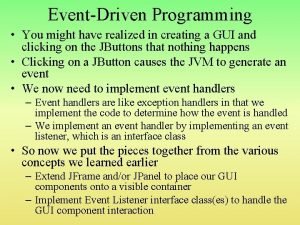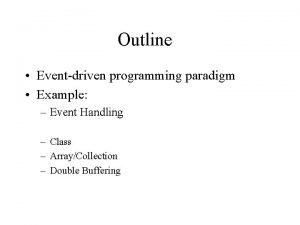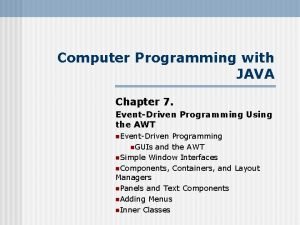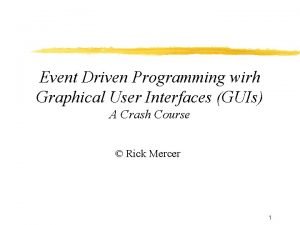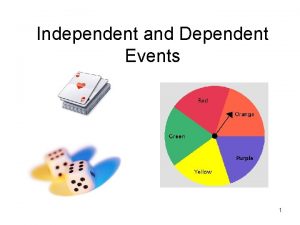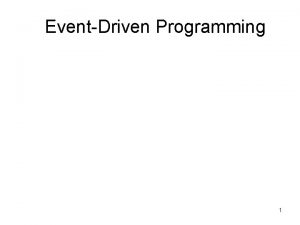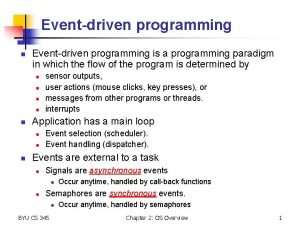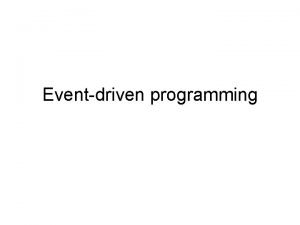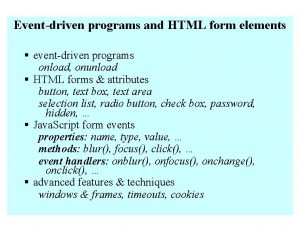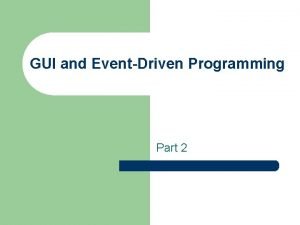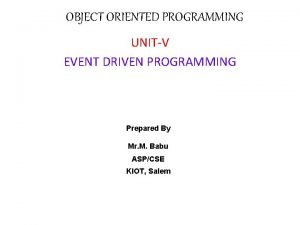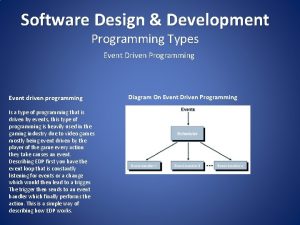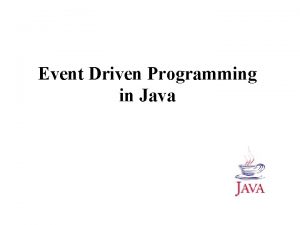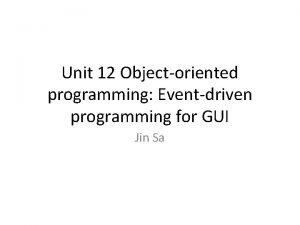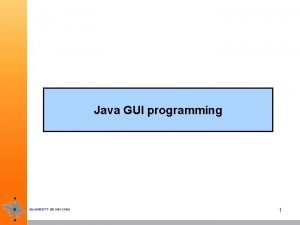Event Driven Programming Eventdriven Programming In the early


















- Slides: 18

Event Driven Programming

Event-driven Programming • In the early days of computing communication with the outside world was accomplished using a technique called Polling. • This is the technique you used with your Mom and Dad when you were little and went on a long trip • Are we there yet? • Are we there yet?

Event-driven Programming • Eventually your Dad said something like, “I’ll tell you when we get there, sweetie. ” • In a like manner early programs would check the keyboard to find out if a key had been pressed and then take action. • As the user interface (keyboard, mouse, screen) became more complex this became problematic. • There was simply too much activity to keep track of what was going on efficiently.

Event-driven Programming • So a system was developed where some very fastefficient code is included as either part of the operating system or the JVM • In this approach the programmer can say when a certain event occurs a certain piece of code should be executed • This is refined and expanded with modern languages by providing programmers with a Graphical User Interface Toolkit • This means that items (referred to as widgets) are preprogrammed in to the system. These include buttons, text areas, etc.

Event-driven Programming • Programmers now have tools to design screen layouts and make them respond as desired. • Today we will show you a small demo and the code that runs it.

Adding Machine • We want a small window that will display • Two editable numbers • One non-editable sum • An ADD Button • A Clear Button

How it works Unlike the other programs you have written event-driven programming doesn’t follow a single path Different objects will be constructed to handle the action when each button is pressed The functionality of the text windows is built-in

The Code import java. awt. event. *; import javax. swing. *; import java. awt. *; class Adder extends Window. Adapter { // The public public widget references JFrame f; JPanel p; JText. Field top; JText. Field bottom; JText. Field sum; JButton add; JButton clear;

The Code // Constructor public Adder() { // Top level window on screen f = new JFrame("Adding Machine"); f. set. Size(200, 200); // Panel to hold components p = new JPanel(); // 3 text fields to hold 2 numbers and sum top = new JText. Field("0. 0", 20); top. set. Horizontal. Alignment(JText. Field. RIGHT); bottom = new JText. Field("0. 0", 20);

The Code // Still in constructor bottom. set. Horizontal. Alignment (JText. Field. RIGHT); sum = new JText. Field("0. 0", 20); sum. set. Horizontal. Alignment(JText. Field. RIGHT); sum. set. Editable(false); // Add and clear buttons add = new JButton("ADD"); add. Action. Listener(new Add. Button. Handler(top, bottom, sum)); clear = new JButton("CLEAR"); clear. add. Action. Listener(new Clear. Button. Handler(top, bottom, sum));

The Code // Still in constructor // How it looks p. set. Layout (new Box. Layout(p, Box. Layout. Y_AXIS)); f. get. Content. Pane(). add(p); p. add(top); p. add(bottom); p. add(sum); p. add(add); p. add(clear); f. add. Window. Listener(this); f. show(); }

The Code // Handle clicking on window close X public void window. Closing(Window. Event e) { System. exit(0); } // Start it up public static void main(String args[]) { new Adder(); } }

Event Handlers import java. awt. event. *; import javax. swing. *; import java. awt. *; class Clear. Button. Handler implements Action. Listener { // Widgets JText. Field top, bottom, sum; // Constructor public Clear. Button. Handler(JText. Field top, JText. Field bottom, JText. Field sum) { this. top = top; this. bottom = bottom; this. sum = sum; }

Event Handlers import java. awt. event. *; import javax. swing. *; import java. awt. *; // Clear all the text fields public void action. Performed(Action. Event e) { top. set. Text("0. 0"); bottom. set. Text("0. 0"); sum. set. Text("0. 0"); } }

Event Handlers import java. awt. event. *; import javax. swing. *; import java. awt. *; class Add. Button. Handler implements Action. Listener { // Widget References JText. Field top, bottom, sum; // Constructor public Add. Button. Handler(JText. Field top, JText. Field bottom, JText. Field sum) { this. top = top; this. bottom = bottom; this. sum = sum; }

Event Handlers // Get text field contents, convert, add and disp public void action. Performed(Action. Event e) { double t, b, total; String t. String = top. get. Text(); String b. String = bottom. get. Text(); try { t = Double. parse. Double(t. String); } catch(Exception e 1) { t = 0. 0; top. set. Text("Error!"); }

Event Handlers try { b = Double. parse. Double(b. String); } catch(Exception e 2) { b = 0. 0; bottom. set. Text("Error!"); } total = t + b; sum. set. Text((new Double(total)). to. String()); } }

 Event driven programming in java
Event driven programming in java Differences between sequential and event-driven programming
Differences between sequential and event-driven programming Event driven programming paradigm
Event driven programming paradigm Event-driven programming in java
Event-driven programming in java Event driven process chain examples
Event driven process chain examples Itil-driven event management processes
Itil-driven event management processes Aml kyc
Aml kyc Abe eda
Abe eda Event driven gui
Event driven gui Staged event driven architecture
Staged event driven architecture Event-driven insurance
Event-driven insurance Event driven process chain examples
Event driven process chain examples Simple event and compound event
Simple event and compound event Language features of news item text
Language features of news item text Independent vs dependent events
Independent vs dependent events Independent or dependent
Independent or dependent 5 w's event management
5 w's event management Sentinel report
Sentinel report Bridge breaks in central java
Bridge breaks in central java
